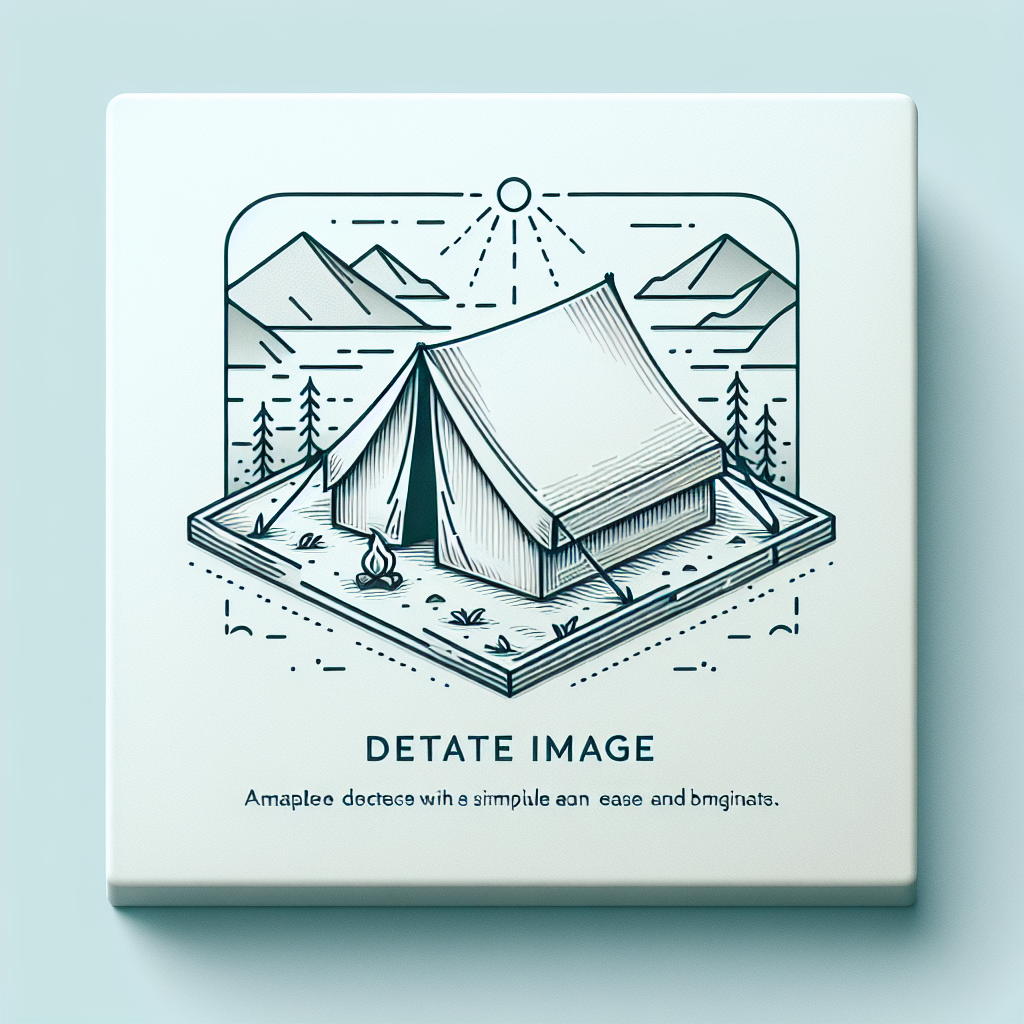You’ve got the perfect camping spot picked out and you can’t wait to spend the weekend surrounded by nature. But then you realize that you’ve never set up a tent before and suddenly panic sets in. Don’t worry, we’ve got you covered! In this beginner’s guide, we’ll walk you through the step-by-step process of setting up a tent, ensuring that you can enjoy a comfortable and stress-free camping experience.
A Beginner’s Guide: How to Set Up a Tent
Setting up a tent can be an exciting and memorable experience, whether you’re heading out for a camping trip in the woods or setting up a tent in your backyard for a fun night under the stars. But before you embark on your outdoor adventure, it’s important to know how to choose the right tent, gather the necessary equipment, find a suitable location, and properly set up and maintain your tent. In this comprehensive guide, we’ll walk you through each step of the process, ensuring that your camping experience is comfortable and enjoyable.
Choosing the Right Tent
When it comes to choosing the right tent, there are a few factors to consider. First and foremost, you’ll want to think about the size and capacity of the tent. How many people will be sleeping in the tent? Will you need extra space for gear? It’s important to choose a tent that fits your specific needs to ensure everyone has a comfortable sleeping area.
Next, you’ll need to decide on the type of tent that suits your camping style. There are various types of tents available, including dome tents, tunnel tents, and cabin tents, each with its own advantages and disadvantages. Consider factors such as ease of setup, durability, and the amount of headroom provided by each type before making your decision.
Checking the weather conditions before choosing a tent is crucial. If you’re heading out on a camping trip during the rainy season, it’s essential to choose a tent with a rainfly and waterproof features to keep you dry. On the other hand, if you’re camping in hot and humid conditions, a well-ventilated tent will help keep you cool and comfortable.
Lastly, take a look at the various features offered by different tents. Some tents come with built-in storage pockets, vestibules for extra gear storage, or even built-in LED lights. Assessing these features and considering your personal preferences can make your camping experience even more convenient and enjoyable.
Gathering the Necessary Equipment
Once you’ve chosen the perfect tent for your camping trip, it’s time to gather the necessary equipment to ensure a successful setup. Here’s a list of essential equipment you’ll need:
- Tent: Your chosen tent is, of course, the most crucial piece of equipment for your camping adventure.
- Groundsheet or footprint: A groundsheet or footprint provides an extra layer of protection for your tent floor, preventing damage from rocks and moisture.
- Tent stakes: Sturdy tent stakes are necessary to secure your tent to the ground, ensuring stability during windy conditions.
- Mallet or hammer: You’ll need a mallet or hammer to drive the tent stakes into the ground.
- Tent poles: Tent poles are essential for providing structure and support to your tent.
- Rainfly: A rainfly is a waterproof cover that goes over your tent to provide additional protection against rain and moisture.
- Guy lines and tensioners: Guy lines and tensioners help stabilize your tent, especially in windy conditions, by increasing tension and preventing flapping.
By ensuring you have all the necessary equipment, you’ll be well-prepared for a smooth and hassle-free tent setup.

Finding a Suitable Location
Now that you have your tent and equipment ready, it’s time to find a suitable location to set up your campsite. Here are a few key considerations for selecting the perfect spot:
Check for designated camping areas in the area you’re planning to camp. These designated areas often provide the necessary amenities and facilities for a comfortable camping experience.
Consider the terrain and ground condition of the area. Look for a location that has relatively flat and even ground to make the tent setup easier and more stable.
Avoid areas prone to flooding or standing water. Camping near a river or in a low-lying area can be risky and uncomfortable in case of unexpected rain.
Take advantage of natural shade if possible. Setting up your tent under a tree or a canopy of branches can provide additional shade and shelter from the sun, making your camping experience more enjoyable, especially during hot summer days.
By carefully selecting a suitable location for your tent setup, you’ll ensure maximum comfort and safety throughout your camping trip.
Preparing the Tent Site
Before assembling your tent, it’s important to properly prepare the tent site. Follow these steps to ensure a clean and hazard-free area for your tent:
Clear the area of rocks, sticks, and debris that may cause discomfort or damage to the tent floor.
Remove any sharp objects such as thorns or stones from the ground that could potentially puncture the tent fabric.
Smooth out the ground by using your feet or a small shovel to create an even sleeping surface and prevent discomfort while sleeping.
Consider using a groundsheet or footprint under your tent to provide an extra layer of protection and minimize wear and tear on the tent floor.
Inspect the site for any potential hazards such as loose branches, ant nests, or uneven terrain that could pose a threat to your safety or the integrity of the tent.
By taking the time to properly prepare the tent site, you’ll ensure a safe and comfortable camping experience.

Unpacking and Organizing the Tent Components
Now that your tent site is ready, it’s time to unpack and organize the various components of your tent. Follow these steps to ensure a smooth and efficient setup:
Lay out the tent fabric and components in an open area, ensuring you have enough space to assemble the tent without any obstructions.
Organize the tent poles and stakes, making sure they are easily accessible and properly sorted.
Check all the tent components for any signs of damage such as tears, fraying, or bent poles. It’s crucial to address any issues before setting up the tent to prevent further damage or discomfort during your camping trip.
Ensure all zippers and closures on the tent are functional and in good working condition. Properly functioning closures are essential for keeping bugs and rain out of your tent.
By unpacking and organizing your tent components beforehand, you’ll streamline the setup process and ensure a trouble-free camping experience.
Assembling the Tent
With the tent components organized and your tent site prepared, it’s time to assemble your tent. Follow these step-by-step instructions for a successful setup:
Start by laying out the tent body on the prepared tent site. Ensure the tent is properly oriented, aligning the door with the desired direction for easy access.
Insert and connect the tent poles according to the manufacturer’s instructions. Be gentle while inserting the poles to avoid any potential damage to the tent fabric.
Attach the rainfly if necessary. Some tents come with an integrated rainfly, while others require you to attach it separately. Make sure the rainfly is properly secured and covering the entire tent to provide optimum protection against rain and moisture.
Secure the tent to the ground using stakes. Insert the stakes through the loops or grommets on the tent corners and drive them into the ground using a mallet or hammer. Be sure to angle the stakes away from the tent for maximum stability.
Adjust the tension on the tent body and rainfly as needed to ensure proper stability and minimize flapping in windy conditions.
By carefully following these steps, you’ll have your tent assembled and ready to go in no time.

Interior Setup and Organization
Once the tent is assembled, it’s time to set up the interior for a comfortable and organized camping experience. Consider the following tips:
Place the groundsheet or footprint inside the tent, ensuring it covers the entire floor area. This will provide additional protection against moisture and help keep the tent clean.
Arrange sleeping pads and sleeping bags in designated sleeping areas. This will ensure everyone has a comfortable and separate sleeping space.
Set up any additional gear storage such as small tables, camping chairs, or hanging organizers to keep your camping essentials within easy reach.
Create designated areas for different activities such as cooking, dining, and relaxing, to maximize space and organization inside the tent.
By setting up the interior of your tent thoughtfully, you’ll create a comfortable and functional living space for your camping adventure.
Dealing with Rain and Moisture
When camping, dealing with rain and moisture is inevitable. Here are some tips to help you stay dry and comfortable during rainy conditions:
Ensure proper rainfly attachment by ensuring it completely covers the tent and is properly secured. A tightly attached rainfly will prevent rainwater from seeping into your tent.
Stake out the tent guylines to increase stability and prevent flapping in windy and rainy conditions. This will help maintain the tent’s shape and prevent water accumulation.
Avoid touching the sides of the tent when it’s raining. This helps prevent moisture transfer from the outside to the inside of the tent.
Consider using a groundsheet or applying a waterproofing agent to the tent floor for added protection against moisture. This will help keep the interior of your tent dry even if the ground becomes wet.
By following these tips, you’ll be well-prepared to handle rainy weather and keep your camping experience enjoyable, even in wet conditions.

Tips for Tent Maintenance
Proper maintenance of your tent is crucial to ensure its longevity and continued performance. Here are some essential tips for tent maintenance:
Properly clean and dry the tent after each use. Remove any dirt, debris, or stains using mild soap and water, and hang the tent to dry completely before storing.
Check for any signs of wear or damage such as tears, fraying, or bent poles. Address any issues promptly to prevent further damage during future camping trips.
Store the tent in a cool and dry place, away from direct sunlight, to prevent discoloration and deterioration of the fabric and waterproof coatings.
Avoid long-term exposure to sunlight, as UV rays can weaken the tent fabric and reduce its overall performance and lifespan.
Periodically inspect and reapply waterproofing agents to maintain the tent’s water resistance. Follow the manufacturer’s instructions for the specific product you are using.
By properly maintaining your tent, you’ll ensure it continues to provide optimal performance and comfort for many camping adventures to come.
Troubleshooting and Problem-solving
While setting up and using your tent, you may encounter some common issues. Here are a few tips to help you troubleshoot and solve these problems:
Fixing broken poles or stakes: Carry a repair kit with extra poles or stakes to replace any that may get damaged during setup or use. Additionally, you can use duct tape or cord to temporarily mend a broken pole or stake in an emergency situation.
Addressing leaking or condensation issues: Ensure the rainfly is properly attached and fully covers the tent to prevent water from entering. To minimize condensation inside the tent, ensure proper ventilation by partially unzipping windows or vents.
Dealing with high winds or storms: Ensure the tent is properly secured to the ground using stakes and guylines. Use additional guylines and tensioners for increased stability. If the winds become too strong, consider seeking shelter in a more protected area.
Preventing insect intrusion: Keep the tent doors closed as much as possible and use mosquito netting if necessary. Avoid leaving food or sweet-smelling items inside the tent, as they may attract insects.
By being prepared to address these common tent-related issues, you’ll be able to enjoy a seamless and trouble-free camping experience.
Now that you’ve learned how to choose the right tent, gather the necessary equipment, find a suitable location, and properly set up and maintain your tent, you’re well-equipped for a successful camping adventure. Remember to always prioritize safety, comfort, and respect for the environment, and enjoy your time spent in the great outdoors! Happy camping!



